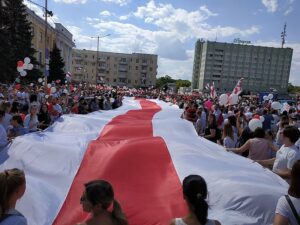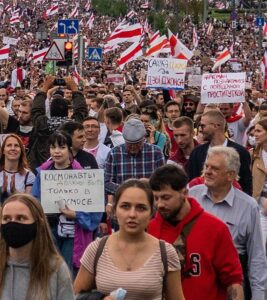Minds of the Movement
An ICNC blog on the people and power of civil resistance
by Svetlana KabanovaJanuary 11, 2021
By remaining nonviolent in defiance of a progressively brutal, 26-year-running dictatorship, Belarusians are embracing life over death but also doing so with a shrewd strategy in mind.
The official results of the presidential election in Belarus last August indicated that more than 80 percent of votes were for the incumbent president Alexander Lukashenko, landing him his sixth consecutive term. But the majority of the population didn’t trust these numbers, believing that only very few people voted for Lukashenko. In response, many thousands of protesters immediately took to the streets to protest election rigging, corruption, and disregard for democratic institutions. They were met by extreme repression not seen in the country since Soviet times—at first seemingly random but eventually targeted and insidious. As of November 15, at least 25,000 have been arrested in relation to the pro-democracy movement, and hundreds more since.
Protesters’ immediate goals are the release of political prisoners and national reconciliation. Their long-term objectives are Lukashenko’s resignation, new and free elections, building democracy in Belarus, and the country’s independence from Russian influence.
The pro-democracy movement truly manifests itself as “beautiful trouble” against the ugliness of its dictatorial adversary. Despite the repression, people continue to disrupt injustice using creativity, joy, courtesy, and humor as tools to unite people in resistance actions, undermine the legitimacy of the violent regime, show that the latter does not exercise control over the population, shift loyalties of Lukashenko’s allies toward the movement, and reinforce nonviolent discipline—all in what might be a protracted struggle against an entrenched dictatorship propped up by its external ally in the Kremlin.
“Game over, Lukashenko!”

Protesters using the historical white-red-white flag in a rally against Lukashenko. August 16, 2020, Baranavichy, Belarus. Source: Wikipedia/Raviaka Ruslan
Up until winter, there were mass demonstrations every Sunday, bringing record numbers in the order of 100,000 or more to the streets. Demonstrators waved banners, posters, balloons, and red and white flowers. (These are the colors of the historical white-red-white flag, which was adopted about a century ago by the independent Belarusian National Republic now it is seen by many as the legitimate national flag). They wore satirical costumes, sang songs, and chanted slogans such as “Game over,” “Go away,” “That’s enough,” “I am scared but I am here,” “You lose,” and “Not you, but people have power.”
Protesters engaged in road closures, online petitions (see here and here for example), fundraising for victims of regime repression, student-led sit-ins at university entrances, and boycotts of regime-associated gas stations and shops. Local meetings among neighbors with tea, cookies, and live music served as important—and joyful— communication channels. Exiled opposition leader Svetlana Tsikhanovskaya called for a general strike for October 26. While workers at numerous companies across the country participated, they were repressed, fired, or reprimanded en masse.
In the midst of these actions, people wore smiles and some carried flowers as their only weapons. What’s more, to reinforce the image of the movement as orderly nonviolent resistance--bucking the government’s labeling of protesters as vandals and hooligans--protesters removed their shoes before standing on public benches during protests and also cleaned up public squares after demonstrations.
As winter arrived, demonstrations grew smaller but more scattered, creating a dilemma for security forces who had a hard time carrying out repression in numerous, unannounced locations at once.
Women’s roles: Leadership, bravery, solidarity
“Our society is not ready to vote for a woman,” Lukashenko remarked at the beginning of the presidential campaign. However, according to both independent online calculations and exit poll data, his opponent, Tikhanovskaya, received over 50 percent of votes. Tikhanovskaya ran as a presidential candidate in place of her husband, Sergey Tikhanovsky, who was arrested and jailed for “inciting violence” before the election (the opposition rebuked the move as intimidation).
In the weeks leading up to the election last August, a female trio against Lukashenko was formed. Svetlana Tikhanovskaya joined Maria Kolesnikova and Veronika Tsepkalo, the representatives of other persecuted opposition candidates. These three brave women did the impossible: They woke the Belarusian people up from hibernation and inertia. Unprecedented numbers agreed to give their signatures and votes for Tikhanovskaya. The brave trio cast a shadow of doubt on Lukashenko’s plan for a smooth victory.

"Women played a primary role in setting the tone for nonviolent mobilization. "March of Unity" Protest rally against Lukashenko, September 6, 2020. Minsk, Belarus. Source: Wikipedia/Homoatrox.
Women also play a primary role in setting the tone for nonviolent mobilization. Women of all ages and professions—nurses, retirees, and others—have formed “lines of solidarity” in the capital of Belarus, chanting “We are united and invincible!” as part of their regular Saturday demonstrations wearing white and carrying flowers. These lines have not only served as physical manifestations of solidarity but also as spiritual chains between a long-oppressed segment of the population. Convoys of cyclists and honking cars have joined in solidarity with the ongoing demonstrations. The Saturday demonstrations were originally sparked by outrage over reports that imprisoned activists were being tortured.
Looking forward
While opposition leaders have general ideas and plans, they aren’t speaking openly about the next steps yet. In fact, many of them are in hiding or in exile. Tsikhanovskaya regularly addresses the Belarusian people via her Telegram channel, while other opposition members are operating via anonymous social media accounts.
The Coordination Council for the Transfer of Power was formed by the opposition in the days that followed the disputed election to ensure a peaceful resolution to the election crisis. However, most of its members have since been arrested. A national reconciliation agency was proposed in late November to hold abusive police accountable for violating protesting citizens’ rights.
As the New Year begins, one thing to keep an eye out for is defections. We no longer see many defections, but in the first months, some members of Belarusian security forces posted videos of themselves throwing their uniforms in dumpsters to protest the regime. It would be important to get to the bottom of exactly why defections have slowed and, especially, how to get them going again (including perhaps appealing to other democracies to use military-to-military contact and/or to provide ways out for police and military who defect, as well as their families).
Another major issue at stake for the future of this movement is the international response to the regime’s actions. Many have criticized the international response as too little, too late. It took more than a month of protests in Belarus for some democratic countries—and for the European Union, it took two months—to respond to regime repression with limited sanctions against select perpetrators.
In the meantime, the people remain committed to beautiful trouble in their struggle for a more democratic Belarus.
Join the conversation on Twitter @civilresistance, hashtag #ICNC2020Top10
Check out our "Top 10 Civil Resistance Stories of 2020, Looking Forward" countdown, with new posts rolling out every Monday from December 14, 2020 through February 15, 2021.

Svetlana Kabanova
Dr. Svetlana Kabanova received a PhD in Biochemistry from the National Academy of Sciences of Belarus and worked in numerous scientific labs both in Belarus and Germany. She is also a writer and poet and has been published in Belarusian, Russian, English, and German. Dr. Kabanova was born in Minsk, Belarus and closely follows political developments and dissidence in her home country as an expat.
Read More